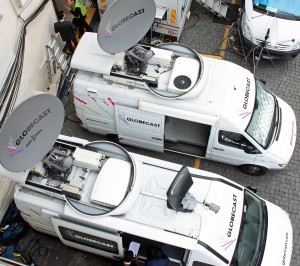The road to Rio: Olympics and occasional use satellite
 The Olympic Games marks a once-in-four-years opportunity for providers of occasional use satellite capacity to make money and innovate. Anna Tobin reports on preparations for Rio.
The Olympic Games marks a once-in-four-years opportunity for providers of occasional use satellite capacity to make money and innovate. Anna Tobin reports on preparations for Rio.
All over the world, occasional use (OU) satellite operators are getting ready for Brazil. The 2016 Olympic Games opens in Rio De Janeiro on August 5, and transmitting a growing, and increasingly tailored, set of sound and images out across the globe poses a huge logistical challenge to all those involved in the OU supply and delivery chain.
Reaching around 3.6 billion viewers worldwide, the 2012 London Olympics was the most watched event in TV history, trumping most individual national broadcasters’ previous ratings records. With multiscreen viewing and interactive preferences still growing, the 2016 Summer Olympics are expected to outperform these figures. The 2014 Football World Cup in Brazil provided a good practice run for OU operators preparing for the Olympics, many of whom are using the same satellites, but they had only just packed up from this campaign before beginning the preparations for these Games.
Eighteen months is the preparation time that Intelsat sets for major live events, according to Peter Ostapiuk, Intelsat’s head of media product services and management. “A major live event, such as the Rio Olympics, requires advanced and precise planning to ensure media customers have the reliable OU capacity they need to deliver exciting live content to viewers,” he says. “We work closely with customers to gather their requirements and then work internally with our capacity managers to identify capacity to successfully support media customers’ coverage plans.”
The test period involves rigorous trailing of systems and solutions and assessing which infrastructures need to be expanded, according to Marc Logez, Globecast’s head of marketing, global contribution. “Modern events are, in many ways, as much about complex logistics as they are about technological solutions. Our customers’ demands can change right up to the last minute and we pride ourselves on finding innovative solutions to meet their needs – often quite late in the process. This is a core part of the value that we bring,” he says.
In order to be able to offer such a rapid response service, OU operators need to be able to second-guess every possible request. They need to cope with mixed delivery to satellite and terrestrial networks and to be technically agnostic in the delivery of upstream and downstream services.
There is no one-size-fits-all solution, says Intelast’s Ostapiuk. “Intelsat works closely with each individual customer to ensure customised bandwidth assignment for optimised efficiency and performance. We offer flexible short-term OU leases ranging from traditional short bookings for one hour, to leases for several weeks or a month,” he says. “Intelsat has also implemented ScheduALL Connector so customers can easily and efficiently secure OU capacity. During major sports events, such as the Olympics, customers need to be able to efficiently manage fluctuating bandwidth demands, while continuing to provide the high-quality, reliable content their viewers demand. The ScheduALL Connector interface allows media customers to easily view Intelsat’s available capacity, quickly match it to their needs and reserve it directly from within their own system.”
It’s also important to remember that the Olympics is now so much more than ‘the Games’ itself. OU services [icitspot id=”565312″ template=”box-story”]will need to be in place in the long run up to the Games too, as the world’s media taps into any, even spuriously, related story. There will be food, travel and culture programming planned that will be filmed and transmitted from in and around Rio leading up to and during the Games. OU operators have to be ready to break stories from the city and its environs too. The Zika virus outbreak, for example, is already proving to be a major side story in this context.
“It’s not just about the primary broadcasters and rights’ holders view of the world,” says Richard Lamb, senior director of OU operations at satellite operator SES. “From our experiences from such big global events, we have found that viewers and our customers have evolved from just looking at the Games themselves, to the more human stories around either the venue or the players. There is a lot more content emanating from the athletes arriving at the airport, the training grounds, etc. There is a lot more focus on the country itself; the Zika virus is a perfect example of how a story can become even more important, because of the Olympics.”
It may not necessarily be the rights-holders looking to tell these stories. For news and entertainment broadcasters, this is where the immediacy of OU satellite technology comes into its own. “Satellite has a ubiquitous advantage of being able to switch on service almost immediately,” says Lamb.
Advances since 2012
Technology and consumers’ expectations of it have moved on, even in the few years since the London Olympics in 2012. There will be even more simultaneous feeds coming out of the Games, more multiple camera angles available and different replay and highlights options. All of this drives bandwidth needs.
Consequently, more operators will be migrating from MPEG-4/H.264 compression to High Efficiency Video Coding (HEVC). “We’ve seen improvements in video encoding – MPEG2, MPEG4 – and we’re now looking at HEVC encoding, which is effectively the next generation. We expect to see an element of this in use at Rio,” says Lamb. “There are improvements in modulation as well, with new standards of DVB-S2x. All of these new techniques, ultra HD, HEVC encoding and higher order modulation will be a part of the Rio Olympics. There is a distinction, however, between what’s being captured locally, what’s being filmed and archived and what’s actually transmitted terrestrially by fibre and what’s transmitted by satellite.”
How much of this actually gets transmitted live over satellite or fibre will be up to the broadcasters. Live content over IP will be another big development to watch for, says Logez at Globecast. “IP-based offerings are developing fast. Live-over-IP will be the next transition, but this will happen in a step-by-step evolution with a hybrid approach, because SDI is a mature technology that is available at a very reasonable price. Nevertheless, several issues still need to be addressed and solved, such as: type of connectivity at the venue, latency, security; and, recruiting new talent with IT specialised know-how,” he says.
It’s not just the transmission technology that has moved forward in the last four years. The way people consume media has altered drastically too, with viewers wanting more content delivered to multiple devices. This has fed into increased demand for IP-based solutions. To thrive, satellite operators have to play a part in delivering this, says Ostapiuk at Intelast. “To meet customers’ needs as the media landscape rapidly changes, Intelsat is expanding its media services with IntelsatOne Prism, a multimedia networking platform and portfolio of managed services that allows customers to easily upgrade a legacy satellite-based network to a next-generation, automated hybrid satellite and terrestrial converged IP network. IntelsatOne Prism accommodates legacy and digital or multiscreen media and optimises network efficiency. It enables programmers to simplify operations with easy management of satellite and fibre capacity,” he says. “IntelsatOne Prism is ideal for the coverage of a special event like the Olympics, during which media customers benefit from automated-access voice, video and data links via two-way connectivity.”
While fibre’s bandwidth capability is impressive and it is playing a growing role in content transmission, it is unlikely to ever make satellite transmission redundant, because fixed networks can’t get to those hard-to-reach places that satellite can. Olympic competitions, such as open-water swimming, cycling and triathlons increasingly take place in remote areas of the host country and OU will always hold the fort here. Nevertheless, fibre is still eating into a chunk of the traditional OU business and many companies have decided that the only way to stop it eroding profits is to make fibre a big part of their own portfolios.
“With regards to worldwide live broadcasting, satellite remains the most viable solution in the majority of cases,” says Logez at Globecast. “Satellite also offers a perfect backup for optical fibre links, especially in the case of highly sensitive video feeds. This is largely because of the lack of a single point of failure between satellite and fibre. Realistically, satellite and fibre cannot really be compared as their usage is very different. They are both part of Globecast’s core business, but also key factors in pushing beyond new frontiers – from a technological or geographical perspective.”
Looking beyond the Olympics, industry participants expect OU to continue to play a primary role in transmitting live events, with a gradual move to more off-site production. “Remote production is now a tried and tested means of covering major live events, or those spread across multiple venues, allowing broadcasters to make cost and manpower savings by centralising the bulk of the production process,” says Logez at Globecast. Globecast’s managed service offering lets clients avoid complex logistics exercise, while the expansion of global IP networks lets the company explore new solutions for main and back up contribution solutions, he adds.
Smaller businesses may also start utilising OU more in the future. In time for the Games, Intelsat launched its first high-throughput next-generation EpicNG satellite, Intelsat 29e, located at 310° East, at the end of January. This is designed to attract smaller businesses as it requires smaller terminals. “Intelsat 29e’s Ku-band spot capacity will be used to support contribution at the Summer Games, enabling customers to gather content from the venues and transport it back to their facilities,” says Ostapiuk. “Intelsat EpicNG delivers increased Megabits per Megahertz, providing customers the high performance they demand, as well as better economics, as they can simply access high-power Intelsat EpicNG capacity with smaller, solar-powered terminals.”
Most of the developments in OU technology, especially the movement to IP, are driven by the demand for greater and greater interactivity, says Lamb at SES. “OU [providers] are gearing up to deliver more virtual reality content and more content for mobile devices. And more people watching the content on lots of different devices drives bandwidth [demand], and that bandwidth ultimately ends up on satellite. Even if it’s about mobile phone via WiFi or cellular technologies, ultimately you will see GSM back-hauling on satellites. There will be large amounts of data going via satellite to provide temporary increases in bandwidth. All of this has a positive effect on the business,” he says. For satellite, it looks like a win-win situation.




